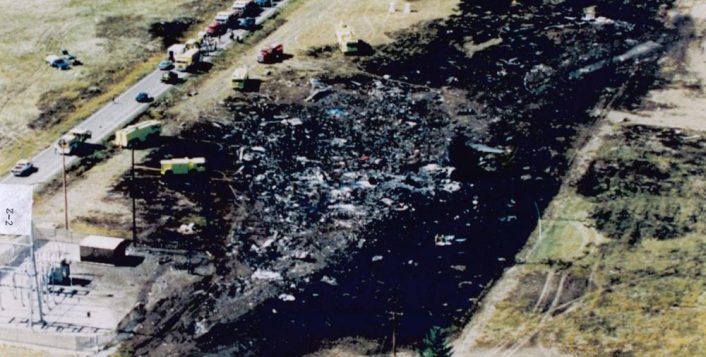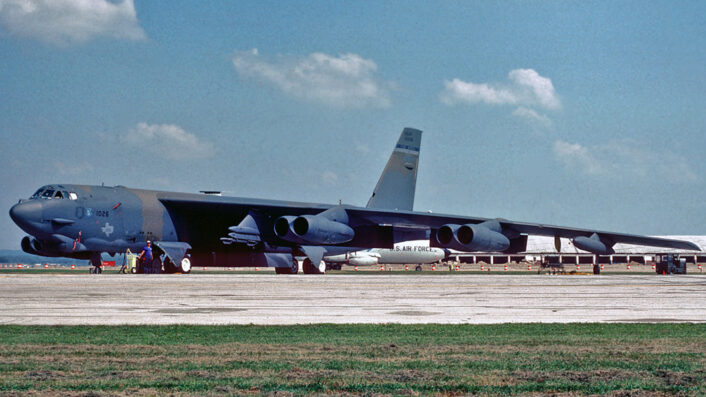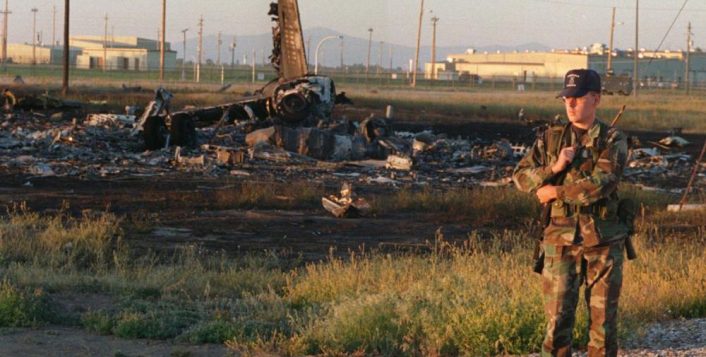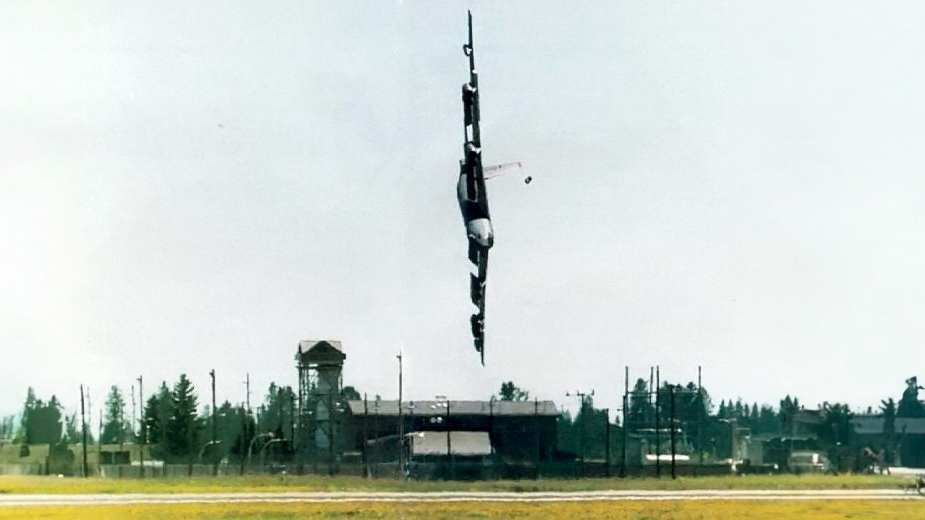The 1994 B-52 crash serves as a stark reminder of the importance of strict adherence to safety protocols and vigilant leadership in aviation.
On June 24, 1994, Fairchild Air Force Base, Washington, witnessed a tragic event that remains etched in aviation history. At 07:30 PDT on that day, a B-52H Stratofortress bomber crew, which included Lt. Col. Arthur “Bud” Holland, Lt. Col. Mark McGeehan, Col. Robert Wolff, and Lt. Col. Ken Huston prepared for a demonstration flight.
Holland, known for his bold flying style, was the chief of the 92nd Bomb Wing’s Standardization and Evaluation branch, responsible for ensuring flight safety standards.
The mission plan for the day was a pretty ambitious display for an aircraft of that size, involving low-altitude passes, 60°-bank turns, a steep climb, and a touch-and-go. Colonel Wolff was the Vice Wing Commander and was added to the flying schedule as a safety observer by Col Brooks, the Wing Commander, on the morning of the mishap: the flight held special significance for him, as it was Wolff’s “fini-flight,” a ceremonial last flight before retirement, attended by his family and friends.
The B-52 61-0026, callsign CZAR 52, took off at 13:58, executing the first part of the display routine successfully.
However, when instructed to go around due to a KC-135 on the runway, Holland requested a 360° left turn around the Tower. Granted permission, he initiated a dangerously tight and steep turn at about 250 feet altitude. Three-quarters through the turn, the aircraft banked past 90°, stalled, and crashed, killing all four crew members instantly. McGeehan attempted to eject but did not fully escape the aircraft.
The investigation highlighted the USAF’s systemic failures, including inadequate mission planning and a lack of corrective actions by superiors. Holland’s superiors had repeatedly witnessed his violations but failed to enforce strict disciplinary measures. The flight’s preparation also lacked thorough briefings, especially for Col. Wolff, who joined the flight at the last minute without knowledge of the mission’s details.
In addition to pilot behaviour, environmental factors, including a 10-knot wind and recent distractions from a mass shooting at Fairchild, contributed to the crash. These distractions potentially impacted the crew’s focus and response during the flight’s critical moments.

Leadership performance under the spotlight
The crash of Czar 52 on June 24, 1994, was the culmination of a series of critical events and leadership failures, as detailed in “Czar 52 – A Prelude to Disaster.” The comprehensive information presented in the document, that analyses six situations that led up to the crash, is derived from AFR 110‐14, Aircraft Accident Investigation Board transcripts, acquired through the Freedom of Information Act, and personal interviews conducted by the author. The analysis incorporates testimonies from 49 individuals and 11 personal interviews, ensuring that no data from the Air Force Safety Mishap Investigation was utilized. The author explicitly avoided reviewing or receiving briefings on the safety board results to prevent any potential conflict of interest.
Each incident leading up to the crash offers valuable insights into leadership performance. The document explores each event, summarizing occurrences based on eyewitness accounts, examining the actions of followers (often B-52 crewmembers), and concluding with an analysis of the leader’s actions. This approach highlights the importance of understanding that historical case studies cannot provide absolute guidance for other situations due to their unique circumstances. Nonetheless, the analysis offers general lessons that may be applicable in other contexts.

Situation One: Fairchild AFB Airshow – May 19, 1991
During the Fairchild AFB airshow in 1991, Lt Col Holland, the pilot and aircraft commander, violated several regulations, including exceeding bank and pitch limits and flying directly over the crowd, which violated Federal Aviation Regulations. Video evidence suggests that he also breached altitude restrictions.
Many crewmembers present during the 1991 airshow were not interviewed, but there was no significant public or private outcry. Some aircrew members, however, began losing faith in the system. One B-52 pilot noted that the wing staff’s passive observation of these violations discouraged others from speaking out, feeling that Lt Col Holland had been granted leniency to flout regulations.
There is no record of commanders taking action against Lt Col Holland’s conduct. Although both the wing commander, Col Weinman, and the deputy commander for operations, Col Julich, were aware of the violations, they took no steps to address them despite their experience and familiarity with the aircraft’s operational limits. This inaction starkly contrasted with Col Weinman’s previous strict enforcement of air discipline during an exercise at Andersen AFB.
Situation Two: 325th BMS Change of Command Fly Over – Jul. 12, 1991
During a flyover for the 325th BMS Change of Command ceremony, Lt Col Holland executed dangerously low passes and steep bank turns, violating Dash 11 Tech Order limits and performing a prohibited wingover maneuver. These actions were neither planned with appropriate oversight nor received the necessary approvals.
As most personnel were at attention during the ceremony, they did not witness the violations directly but were aware that senior staff observed them. Consequently, they might have felt no need to report the incident.
This time, leadership took some action. Col Capotosti, the ADO, expressed concerns about safety and the negative perception among younger aircrews. Although there may have been verbal reprimands, no formal punishment ensued, as confirmed by the outgoing Bomb Squadron commander, Lt Col Harper.
Situation Three: Fairchild Air Show – May 17, 1992
Lt Col Holland once again pushed the limits during the 1992 Fairchild airshow, performing low altitude steep turns and high-speed passes followed by high pitch climbs. These maneuvers exceeded Dash 11 Tech Order limits, and necessary waivers were not obtained.
Junior crewmembers refrained from voicing their concerns, possibly due to the senior staff’s presence during the performance. One pilot expressed astonishment at the continued leniency shown to Lt Col Holland.
The planning phase for this airshow lacked proper command structure due to various absences. Col Capotosti, who would soon become the DO, was determined to prevent future violations by Lt Col Holland. However, disciplinary measures were not documented, and no waivers for the B-52 demonstration were acquired. The outgoing DO left the issue for his successor, who then took steps to reprimand Holland but failed to document or effectively communicate the reprimands.
Situation Four: Global Power Mission – Apr. 14‐15, 1993
During a Global Power mission, Lt Col Holland flew in close formation with another B-52 for photographs and allowed a crew member to film bomb releases from the bomb bay, both actions violating ACC regulations.
Crewmembers participated in these unauthorized activities, reportedly believing they were following wing commander’s directives to obtain good pictures. The resulting evidence clearly showed regulatory breaches.
The squadron commander, Lt Col Bullock, allegedly attempted to coerce a crewmember using the video as leverage, leading to the crewmember filing an unsuccessful complaint with the base JAG. Lt Col Bullock denied these allegations, claiming no explicit knowledge of the illegal activities.
Situation Five: Fairchild Air Show – Aug. 8, 1993
Lt Col Holland’s 1993 Fairchild airshow performance included steep turns, low altitude passes, and a near-vertical climb, all exceeding Technical Order guidance and conducted without required approvals.
By this time, crewmembers had become accustomed to Holland’s routine violations. The bad example set by Holland began influencing junior officers, leading to dangerous imitations and near-disasters.
No disciplinary action was taken despite the evident rule violations, and the leadership’s credibility continued to erode.
Situation Six: Yakima Bombing Range – May 10, 1994
On a mission to the Yakima Bombing Range, Lt Col Holland flew well below the minimum altitude, joined an un-briefed formation of A-10 aircraft, and ignored crewmembers’ warnings. Crewmembers later reported these actions, refusing to fly with him again.
During the mission, crewmembers vocally opposed Holland’s actions. Captain Eric Jones, the co-pilot, resorted to feigning illness and other tactics to ensure safety, ultimately grabbing the yoke to prevent a crash.
After the mission, squadron staff took action, with Major Don Thompson and Lt Col Mark McGeehan deciding that Lt Col Holland should be grounded. However, the DO, Col Pellerin, chose only to reprimand Holland verbally, ignoring the severity of the violations and failing to review crucial evidence. Lt Col McGeehan then restricted his crews from flying with Holland unless he was present, determined to prevent further incidents.
Situation Seven: Fairchild Air Show practice – Jun. 24, 1994
This is the final mission, the one that ended with the aircraft stalling and crashing, killing all four crew members aboard.
The crew members involved in the final flight were Capt Mark McGeehan, Maj Ken Huston, Lt Col Robert Wolff, and Lt Col Arthur Holland. By this time, several of them had expressed concerns about Holland’s flying behavior. Capt McGeehan, in particular, had refused to allow his crews to fly with Holland unless he was present to monitor the situation. However, the broader atmosphere of reluctance to challenge Holland’s authority persisted.
Lt Col Holland’s chain of command, including Col Pellerin, had failed to take decisive action despite repeated warnings and previous violations. The verbal reprimands and informal attempts to control Holland’s behavior proved insufficient. In the days leading up to the crash, there were no concrete steps taken to either ground Holland or impose strict supervision over his flights.
The lack of proper disciplinary measures demoralized other crew members and fostered a sense of helplessness. The repeated violations without consequences eroded trust in the command structure, ultimately leading to a catastrophic breakdown in safety protocols.

Aftermath
Following the crash, the USAF sought to address these failures. Col. Pellerin, the Deputy Operations Commander, was court-martialed and found guilty of dereliction of duty, highlighting the leadership’s role in the tragic event.
The crash underscored the importance of enforcing safety protocols and addressing unsafe behavior decisively. To stress the importance of strictly adhering to existing safety protocols and correcting violations immediately, the USAF rapidly disseminated the investigation’s findings across the service. Despite these efforts, sixteen years later, a similar accident occurred under almost identical circumstances when a C-17 Globemaster III aircraft crashed shortly after taking off from Elmendorf Air Force Base, Alaska, during a practice flight for an aerial display.
Conclusions
The crash of Czar 52 on 24 June 1994 was a tragic outcome of systemic leadership failures at multiple levels. The documented incidents leading up to the crash reveal a pattern of negligence and a critical lack of accountability. This case underscores the imperative for military leaders to enforce standards rigorously and prioritize the safety of their personnel above all else.
The Fairchild B-52 crash serves as a cautionary tale in aviation history, illustrating the dire consequences of ignoring safety regulations and failing to address repeated unsafe behaviors. The lessons from this tragedy are now integral to training programs, emphasizing the critical importance of strict adherence to safety standards and proper crew resource management.













